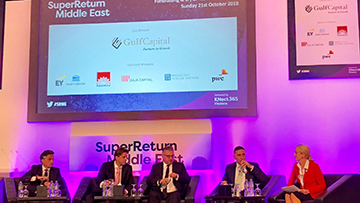Eyes On Dubai: Evaluating The Gulf Region As A Startup Haven
April 4, 2018
When you first arrive in Dubai, your eye is drawn to the skyline, and up, up, up the silvery spire of the Burj Khalifa which reminds you—that no, the sky isn’t the limit here.
But the ground-level question for oil-rich places like these is whether they can diversify their economies by climbing the charts in startup activity. Seven years ago we launched our VC firm in Singapore, and were fortunate to catch its takeoff as a hub for Southeast Asian entrepreneurs.
Now, turning to the Gulf—with a particular eye, at present, on Dubai—we see many of the same factors and forces that have driven Singapore’s rise. Don’t say “mission accomplished” yet. While the Gulf’s potential is great, the ecosystem is emergent, not well-rounded and robust. Here’s a roundup of key strengths and needs we are finding. This is based on input from local experts, plus parallels to the situation in Singapore.
Inherent advantages
The United Arab Emirates (UAE), which includes Dubai and the capital, Abu Dhabi, have a total population of about 9.2 million. Comparing that to Singapore’s 5.7 million, both are dense hubs of innovation that have tremendous internal diversity and external reach to their neighboring region.
More than two-thirds of the people in the UAE are foreign residents. This large pool of foreign talent is a similarity shared with Singapore, and an asset for innovation. Innovation is more likely to occur when people with different backgrounds use different perspectives to solve the same problem – just as in the U.S., where a 2016 study found that over half the founders of billion-dollar-plus tech startups were immigrants (including Tesla, Google, Facebook, and YouTube).
Though Arabic is the official language of the Emirates, English is used fluently everywhere, another advantage shared with Singapore. And though the Arab states are different culturally and socially from most Western or Asian countries, the UAE—like Singapore—seems to have found a sweet spot in this regard. Many foreigners find the differences stimulating but not difficult to adjust to.
Shaikha Ahmad Al Falasi, a civil engineer, uses an interactive digital control panel to monitor environmental features in the Passive House that is designed specially for hot and humid climates, on the grounds of Mohammed Bin Rashid Space Centre in Dubai, United Arab Emirates (Khushnum Bhandari/Bloomberg)
Now consider external reach. Just as Singapore deals regularly with the rest of Southeast Asia, any Gulf state has access to a large surrounding area with cultural similarities: the entire MENA (Middle East-North Africa) region. This “allows business to scale across the region with ease, from a product strategy standpoint,” says Vinay Ramkumar, Investment Analyst at BECO Capital in Dubai.
Ramkumar also notes that startups in the Gulf enjoy an advantage not prevalent across Southeast Asia: consumer wealth. The Dubai-based ride-hailing service Careem “has a higher ARPU [average revenue per user] in the region than Uber does in the U.S.,” he says, while the Kuwait-based online food-ordering platform Talabat “has the second highest basket size and the highest order frequency in the world.”
Careem is seen as a pace-setting MENA startup. It pushes to recruit female drivers, operates in countries as distant as Pakistan, and soundly beats Uber and Lyft in its home region. Another home-based hero firm is e-commerce retailer Souq, once called the Amazon of the Middle East and now literally so. Amazon acquired Souq last year, a rare move for the Seattle giant, which usually expands by out-spending local competitors, but judged this one too good to fight with.
Ecosystem needs
Souq and Careem are success stories. However, there are struggle stories too, along with calls for improvement.
Zach Finkelstein, VP of Corporate Development at Careem, says that while his company has enjoyed the “great infrastructure” and business-friendly regulation within the UAE, “the other 600 million people in our region are harder to reach.” Many don’t have credit cards, so they pay in hard-to-process cash, and Careem has “had to navigate different regulators and regulatory frameworks in each of our markets.”
Nor is the latter problem limited to ride-hailing. Expanding and working across the MENA countries generally isn’t as easy as in, say, the E.U. BECO’s Ramkumar is just one of many who hopes for more inter-country collaboration to help ease “cross-border transactions” and company-building.
All elements of the startup ecosystem need further development. Despite the region’s wealth, there remains a shortage of investment in new tech companies. “In the GCC [Gulf Cooperation Council countries], where VC ecosystems have yet to take root, governments will have to play a more significant role,” says Fahad AlOmran, CEO of Narmo Capital in Bahrain.
Others echo the sentiment, noting that the region’s sovereign wealth funds tend to invest outside the region when it comes to tech. By contrast, Singapore’s growth wave was fueled when the government poured hundreds of millions of U.S. dollars per year into its own startups, typically investing behind private VCs who understood how best to evaluate high-risk startups yet to be proven, a precedent worth emulating.
Construction cranes operate at the building site for the World Expo 2020 exhibition in Dubai, United Arab Emirates (Khushnum Bhandari/Bloomberg)
More on Forbes: Modi Visits Dubai: Growing Investment From The UAE Into India Is Boosting Bilateral Ties
There are also lessons to be learned from mistakes in the early years of Southeast Asia’s ecosystem. Many early “angel investors” were wealthy families from traditional businesses that didn’t adjust their expectations when dealing with young tech firms. Often these investors want an active role in decision-making, and they push for early profitably. It’s better to trust the founders’ knowledge while knowing that high-risk/high-reward ventures may take time to pay off.
AlOmran says even savvy investors can be wary of Gulf startups, due to “the lack of exit options within the GCC region and the limited track record of entrepreneurs / strategic investors that add genuine value.” His wish list includes more of both, plus “increased collaboration and co-operation” among the region’s nascent startup communities and more “channels to facilitate VC knowledge transfer from established hotspots such as Silicon Valley to the GCC.”
I hear a similar tune from entrepreneurs. “We need more, more, more of everything,” says Mohamed Parham Al Awadhi, a distinctive figure on the Dubai scene. Al Awadhi is an award-winning Emirati filmmaker and entrepreneur. He runs the communications firm Qissa, a consultancy that services government authorities across the UAE—on top of that, he’s trying to launch a new startup, Headlight.
The new venture could be established much faster if he could get funds to work on it full-time, he says, adding that foreigners in Dubai face a tougher obstacle: If they leave their regular jobs to put sweat equity into a startup, they lose their work visas.
Singapore has a program to address that issue. Called EntrePass, it offers entry to prospective founders with good business plans; Chile has a similar deal as part of its Start-Up Chile initiative.
Looking ahead
Efforts are being made to enhance the Gulf’s ecosystem. Dubai boasts a technology park, Dubai Silicon Oasis, which provides seed capital and support programs for startups and is also a tax-exempt “Free Zone.” At the grassroots level there are groups like Dubai Angel Investors and Startup Grind Dubai, essential for building community.
Ramkumar thinks the UAE may be only “about two years” behind Singapore’s growth curve. We’ll see. Signs of real growth would include successful founders becoming investors, and firms that move beyond regionalized e-commerce into fundamental world-serving lines of business. (Some of China’s online titans are now trying to make this leap, with ventures into areas such as AI and self-driving cars.)
Finally, for any place looking to migrate an economy from natural resources to tech, there’s a precedent that set the gold standard. The San Francisco Bay Area grew from the Gold Rush of 1849. Wealth earned in the boom financed the founding of Stanford University in 1891, plus a 1909 company called Federal Telegraph, which spawned early telecom spinouts and an environment for Hewlett and Packard to start an electronics company in 1939, laying the groundwork for what is now Silicon Valley.
That process took many decades to bear fruit. We are all aware that progress happens in a fraction of the time now. Keep an eye on Dubai—and on the rest of the Gulf region.





